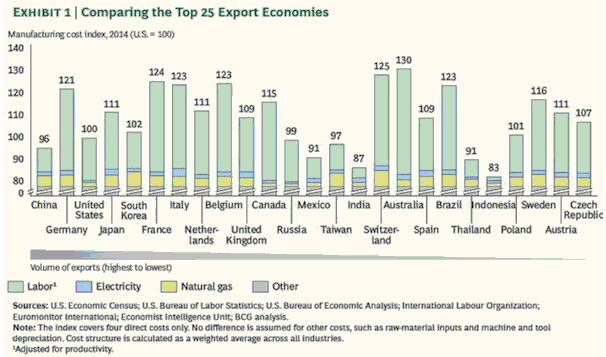The following chart is very interesting. I found it in John Mauldin’s latest “Thoughts from the Frontline” letter, although it was created by the Boston Consulting Group. It compares the cost of manufacturing in the top 25 exporting countries.

According to this chart, Australia is now the most expensive country to manufacture stuff. Manufacturing costs in Australia are now 30% higher than in the US, almost 20% higher than in Japan, almost 10% higher than in Germany, and about 5% higher than in Switzerland. The cost of manufacturing in the US is now slightly below the average — at around the same level as South Korea, Russia, Taiwan and Poland. This means that the Fed is almost half way to its goal of reducing US living standards to the point where the average factory worker in the US can compete on a cost basis with the average factory worker in Indonesia.
The above comment is only partly tongue-in-cheek. Many pro-free-market commentators discuss the decline in US living standards as if it were an unintended consequence of the Fed’s policies, but there is nothing unintended about it. It is a deliberate objective. The Fed will never come out and say “we are doing what we can to reduce living standards”, but a policy that is designed to boost asset prices, support capital-consuming businesses and promote investments that would never see the light of day in the absence of artificially low interest rates, all while minimising “wage inflation”, is also designed to reduce real wages and, therefore, to reduce living standards. The Fed surely doesn’t want to reduce US living standards to Indonesian levels, but that’s the direction in which its efforts are deliberately pointed.
I’ve explained in TSI commentaries that the root of the problem is unswerving commitment to bad economic theory. Under the Keynesian theories that all central bankers religiously follow, wealth is something that just exists. There is no careful and deep consideration given to how the wealth came to be and why some countries managed to accumulate a lot of wealth while other countries remained poor. According to these theories, people spend more during some periods due to a vague notion called rising “animal spirits”. This causes the amount of wealth to grow. Then, after a while, the mysterious “animal spirits” begin to subside, causing people to start spending less. This leads to a reduction in the amount of wealth. Under this perception of the world, one of the central bank’s primary tasks is to combat the unfathomable and destabilising natural force that drives the shifts in spending. This is done by indirectly manipulating prices throughout the economy, including the real price of labour.
The so-called counter-cyclical policies are destined to backfire, but the nature of the eventual backfiring is often difficult to predict. In broad terms, there are two possibilities: There could be a surge in inflation fear followed by a collapse in asset prices, a recession and a moonshot in deflation fear, or the collapse in asset prices and its knock-on effects could happen without a preceding surge in inflation fear. In both cases, the asset-price collapse and recession would likely usher-in a new round of ‘stimulative’ policy, because the devotion to bad theory prevents the right lessons from being learned.
 Print This Post
Print This Post
